"The bones lie thickly strewn on the mud - leg bones, shoulder blades, teeth and, most dramatic of all, skulls. All are a delicate pale cream colour as though they were specimens straight from an anatomist's cleaning bath." Attenborough (1979).
These were the words of Sir David Attenborough after he visited the Ossuaries. Regardless of previous experience, one cannot help but gaze in awe at the incredible site that appears before your eyes. After squeezing through a small entrance one is surrounded by a 'sea of bones' with the skeletal remains of hundreds of animals scattered all around you. Trapped many thousands of years ago, it is easy to imagine the fear and hopelessness of their situation, fumbling about in the dark trying vainly to escape. The moment was not lost on Attenborough who visited the site in 1978 while filming for his Life on Earth series.
THE OSSUARIES
Deep in Victoria Fossil Cave in the Naracoorte Caves World Heritage Area are the Upper and Lower Ossuaries. Discovered in the early 1970s by Barry Wright and Ron Galbreath (Reed & Bourne 2000), they contain immensely rich deposits of Pleistocene vertebrates. Strewn across the clayey-sand sediment floors of the chambers are exceptionally well preserved skulls and bones of extinct animals, including articulated portions of skeletons. The unique nature of these deposits was recognised early by researchers and only a small number of specimens were collected for taxonomic identification with the deposit left un-excavated for future reference. Flinders University Honours student Robyn Gill attempted some preliminary dating work in 1996, the only other research undertaken in the chambers. The fossil vertebrate taxa represented in the site were listed in 2000 (Reed & Bourne 2000), based on collections held at the South Australian Museum and some preliminary field identifications.
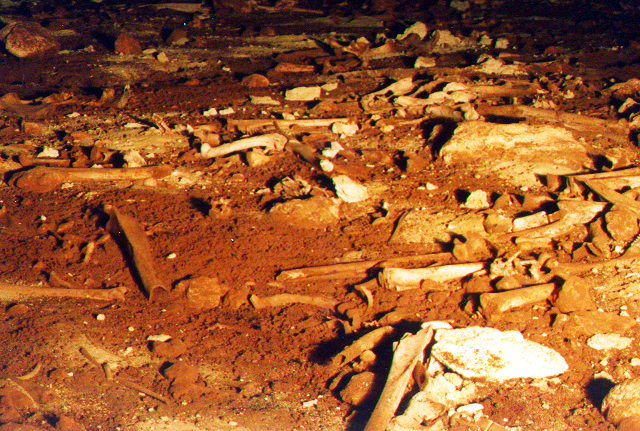 |
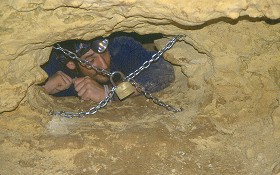 |
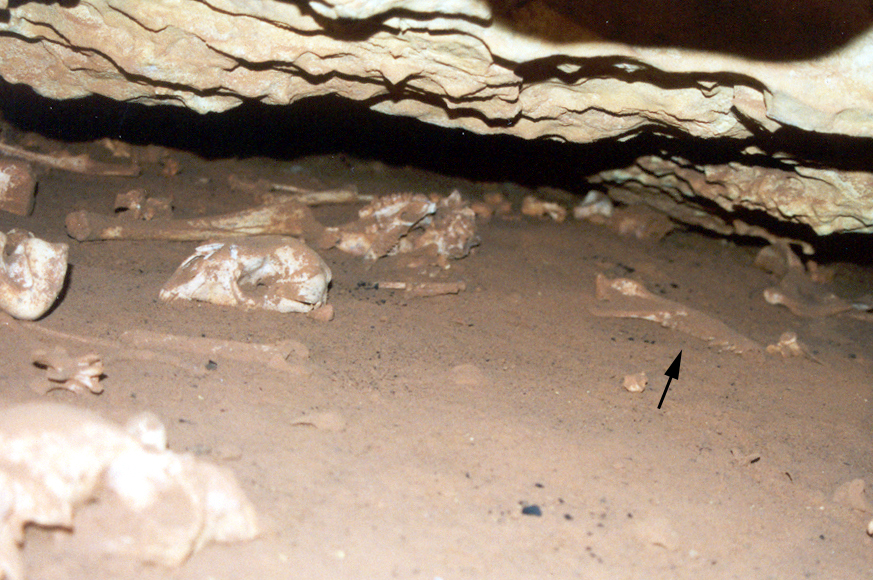 |
A Scatter of Bones in The Ossuaries |
The Ossuaries are well protected! |
The skulls of extinct sthenurine kangaroos and the dentary of a Thylacine indicated by the arrow. |
Cavers from the Cave Exploration Group of South Australia (CEGSA) assisted park management with the installation of track marking from the main Fossil Chamber to the Ossuaries in 1996, defining a clear route for all researchers visiting the site. Over the past 20 years the site has received very limited visitation. The Ossuaries have become an icon over the years with many myths perpetuated. For example, the exaggerated one km crawl from the main Fossil Chamber to reach the Ossuaries is actually about 250 m and some of this is walking passage. But no-one has exaggerated the sight of the bones lying on the sediment floor.
A PROBLEM WITH MANAGEMENT PLANS
Departmental management plans are often fairly brief, outlining broad management objectives and policies. Implementation may be difficult unless sufficient information is readily available to assist the manager with decision-making. The Ossuaries chambers are classified in all three Naracoorte Caves Management Plans since 1986 as a reference site, meaning;
"to be protected against further disturbance as far as is practicable, and access will be only with written approval for research specifically related to baseline functions of the cave, and where such research cannot reasonably be carried out elsewhere in the State".
- Naracoorte Caves National Park Management Plan (2001)
The 1986 management plan for Naracoorte Caves Conservation Park (the park was not designated National Park until 2001) mentions "bones in silt" in the Ossuaries, while the 1992 plan states " ... The Fossil Chamber and The Ossuaries in Victoria Fossil Cave containing one of the richest deposits of more recent Pleistocene vertebrate fossils in the world". Impressive description, but no map or other information to show where the Ossuaries actually are!
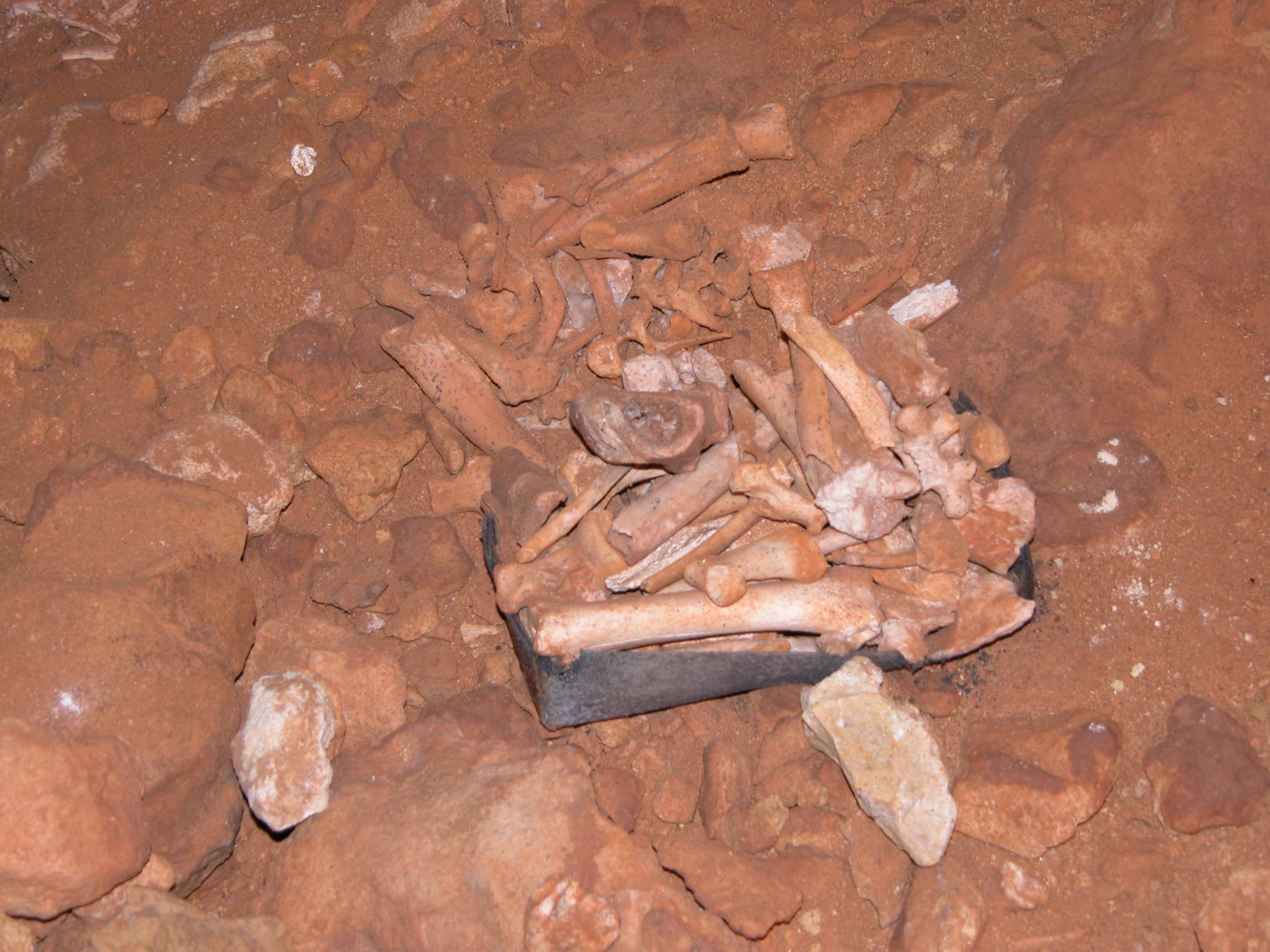 |
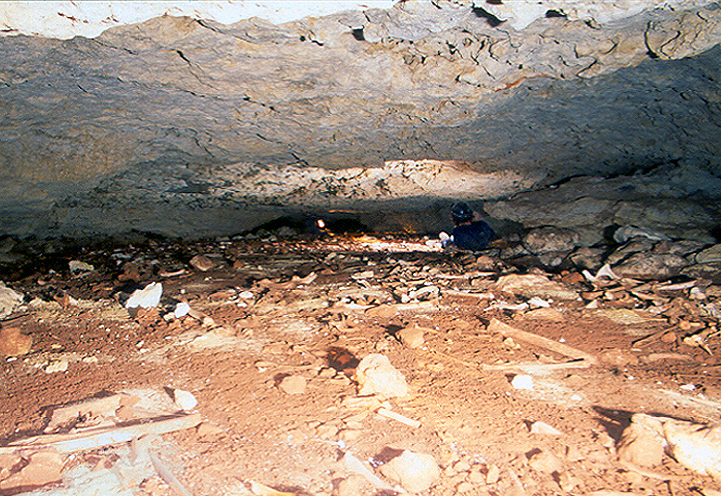 |
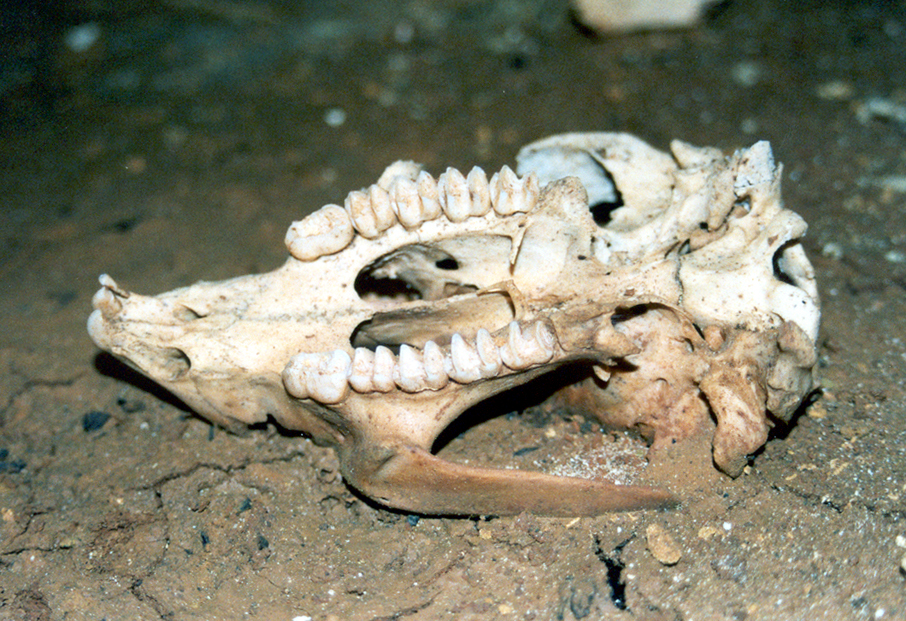 |
Displaced bones in The Ossuaries |
A chamber-wide view of The Ossuaries |
A skull in situ in the Ossuaries |
The 2001 Management Plan merely states the area "is still to be studied" although a map of Victoria Fossil Cave was included showing the classification of areas of the cave. While the Ossuaries has been well protected by a long term manager, written information relating to this area is virtually non-existant providing no baseline data for adequate future management.
This paper describes a project that was completed recently in the Ossuaries to provide this baseline data and research the surface scatters of bones.
OBJECTIVES OF THE PROJECT
The large vertebrate bone scatters of the Ossuaries chambers provide a unique opportunity to study an un-excavated Pleistocene deposit that is analogous to that of the Fossil Chamber in terms of fauna, chamber morphology and size (Reed & Bourne 2000). An in situ investigation of the material lying on the floor surface allowed analysis of one depositional layer or unit, thus providing further insight into interpreting the processes leading to the formation of deeply stratified deposits like the Fossil Chamber.
The research objectives of the project were to collect baseline data via a survey and acquire taphonomic data for the PhD project of one of us (Reed). The challenge was to gather data and map the chambers without disturbing the floor. The site was also photo documented and this combined with the map and associated data, would assist with better management of the site. This was the most comprehensive study of the Ossuaries and the first to provide baseline data for future reference.
The Naracoorte Caves National Park is a World Heritage listed fossil site and as such is subject to international scrutiny with regard to its protection and management. Research is vital to understanding and interpreting the World Heritage values, however, it must be conducted in such a way as to not jeopardise these values. A requirement is the production of a Periodic Report every six years to UNESCO. Establishing a program for monitoring of fossil sites is difficult but this project has provided information that will assist in producing this report. We envisage that photographic evidence may become a part of this monitoring and reporting process in the future, rather than a long wordy report.
Fossil deposits within the caves are finite resources and it is crucial that each excavation extracts maximum information. Over the past century there has been a gradual shift from the mere collection of fossils and the construction of faunal inventories of sites, to investigations concerned with broader palaeobiological issues such as palaeoecology, functional morphology, chronology and extinctions. This has no doubt been fuelled in part by technological advances, particularly with the development of absolute dating techniques. Protection and preservation of part of each site in addition to some whole sites will ensure future researchers will be able to carry out their work.
In addition, fossil sites should considered not merely in terms of scientific values, but management should incorporate interpretive, historic, tourism and aesthetic values. A significance approach, as used by heritage assessors, is an ideal tool and one now being implemented at Naracoorte Caves.
MAPPING THE OSSUARIES
A pathway had previously been defined through the Ossuaries and all mapping data were taken from it. The chambers were mapped by running a tape measure along a centre-line (following the pathway) and measuring the distance to the walls and the roof height with a Disto Classic TM laser rangefinder at every 0.50 metres along bearings defined by a digital compass.
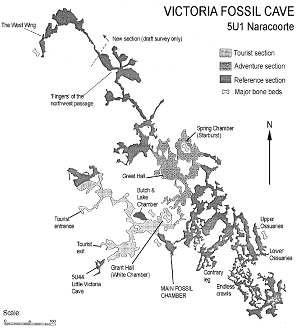 |
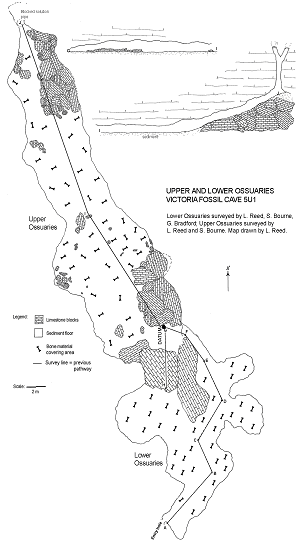 |
A map of Victoria Fossil Cave |
Map of The Ossuaries |
A huge amount of data was collected, including location data and identification of as many bones as possible, features such as rockpiles, associated and articulated sub assemblies, modified bones and any other feature of interest. The entire site was extensively photographed (over 300 images were taken) using an SLR camera and a range of lenses. Lastly, the survey was tied into the survey of the rest of the cave completed by CEGSA.
DESCRIPTION
Although designated the Lower and Upper Ossuaries, the Ossuaries forms a single, large chamber with areas of rock collapse defining the two areas. The combined Upper and Lower Ossuaries are approximately 63m long and 18m at the widest point. The floor surface area is around 475m2 and roof height is generally less than one metre. Unlike adjacent chambers, the Ossuaries are devoid of calcite formation. The main entry point for sediment and animals was probably a solution pipe at the northern end of the Upper Ossuaries chamber (Figure 1). The pipe is 70 to 80cm in diameter on average and extends upwards as a single pipe for four metres before branching into twin pipes that continue for approximately another two metres where they are blocked (Figure 1). At this stage the depth below land surface is not known, although the approximate surface location has been determined to avoid accidental unblocking.
DISCUSSION
Caves are arguably the most sensitive of all sites for palaeontological investigation, where deposits are spatially contained, finite resources and often the cave has a wealth of other natural values. Many people have a speleothem-centric view of caves and other features such as sand cones, sediment floors and fossils are seen as being of less importance than calcite deposits. A more holistic view of caves is required to ensure all significant features are protected, however, determining significance and prioritising can be a long and costly process.
During the 19th century, when palaeontology was a young science, the focus was placed almost entirely on the collection and taxonomic description of fossil specimens. New species were being discovered at a rapid rate and these needed to be described and arranged according to the Linnean system. As a result of this, many fossil sites were treated as collecting venues and in many cases sites were emptied of their fossilised remains. There is a vast difference between collecting fossils and palaeontology as we know it today. Modern palaeontology is very much a multi-disciplinary endeavour. We now have the advantage of radiometric dating and new technologies that allow us to study the past in ways that could not have been imagined in the 1800s. Today's focus is on reconstructing past environments and animal communities and slowly, many palaeontologists are adopting an holistic approach to the investigation of fossil sites.
An almost tacit assumption is that significance is measured in terms of taxonomic diversity. World Heritage criteria for fossil sites focus on representativeness, outstanding preservation, period of time and quality of fossil material, in other words the complete story (Wells 1996). The Ossuaries are an important part of the Naracoorte Caves' World Heritage story, providing a small part of a much bigger story. They are significant because they represent a largely in situ deposit of Pleistocene mammals. The deposits are a unique feature of the Naracoorte Caves World Heritage values, as we know them today. Another site may be found to rival these or even the Fossil Chamber in the future, but at present they are rare for their completeness. The taphonomic data suggests the Ossuaries acted as a pitfall trap for large mammals, and shares features of the fauna and bone assemblage with other deposits from Naracoorte, in particular the enormous Fossil Chamber deposit. The Ossuaries provide an extremely useful analogue for the accumulation and dispersal of remains in caves at Naracoorte. Investigation of the Ossuaries has developed methods to assess the next big new deposit, when and if it is discovered.
We have also demonstrated the value of retaining undisturbed fossil sites for research with the completion of the taphonomic study. Too often bones are removed from caves when discovered and context is lost. As palaeontology studies become more technologically advanced, more and more information is gleaned from the bone's location, rather than the bone itself. It is obvious that an urgent review is needed of the Australian Speleological Federation's Minimal Code of Impact with regard to palaeontological values of caves, in particular rule 18;
"If bone material is found on existing or proposed tracks it should be moved off the track to a safer location if at all possible. Collection should only be undertaken with appropriate permission". Australian Speleological Federation (1995)
This is in fact in breach of the South Australian National Parks and Wildlife Act, 1972 that states;
"A person must not, without the permission of the Director:
... - remove or displace any rock, mineral or fossil in a cave."
We contend that bone material should be left alone until a proper assessment of the site can be made, whether the cave is within a protected area or on private land.
Loss of "corporate knowledge" is a serious problem in many organisations and this may be especially so in the case of cave systems. One manager may preserve a cave for many years, only to have the cave's values destroyed, simply through the failure to document special values for the benefit of the next manager. Management plans are also open to personal interpretation so more information available on any given site to a manager will assist in consistent decision-making. In the case of fossil sites, information may be presented in scientific journals but never presented to park management in a readily understood form. This project has collated a valuable resource for managers and researchers alike, clearly documenting the contents of the Ossuaries, while using low impact methods.
We have highlighted the benefits of managers and researchers working together to allow each to achieve their own objectives. Managers with their responsibility for protection of a park and providing tourism experiences, with researchers as users that may be very specific in their requirements and ignorant of other values. Technology assisted in completing a taphonomic study without excavation and minimal impact and provided management with excellent baseline data of the Ossuaries. None of this, however, would have been possible if it were not for the foresight of previous managers and researchers who resisted the temptation to exploit this wonderful resource.
REFERENCES
Attenborough, D. (1979) Life on Earth. Collins, London.
Australian Speleological Federation (1995) Minimal Impact Caving Code.
Department for Environment and Heritage (2001) Naracoorte Caves National Park Management Plan
Department of Environment and Planning (1992) Naracoorte Caves Conservation Park Management Plan
National Parks and Wildlife Service of South Australia (1986) Management Plan Naracoorte Caves Conservation Park.
Reed, E. H. (2003) Vertebrate Taphonomy of large mammal bone deposits, Naracoorte Caves World Heritage Area. Unpublished PhD thesis, The Flinders University of South Australia.
Reed, E. H. & Bourne, S. J. (2000) Pleistocene fossil vertebrate sites of the South East region of South Australia. Transactions of the Royal Society of South Australia 124, 61-90.
Wells, R. T. (1975) Reconstructing the past: excavations in fossil caves. Australian Natural History 18, 208-211.
Wells, R. T. (1996) Earth's Geological History: A contextual framework for assessment of World Heritage fossil site nominations. IUCN, Gland, Switzerland.
Wells, R. T., Moriarty, K. C. & Williams, D. L. G. (1984) The fossil vertebrate deposits of Victoria Fossil Cave Naracoorte: an introduction to the geology and fauna. Australian Zoologist 21, 305-333.